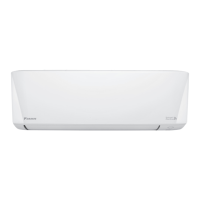22
Installation Guideline
• When ared joints are reused indoors,the are part shall be re-fabricated.
• Avoid installation of the air conditioner in a place where there is danger of exposure to continuously operating
open ames (for example an operating electric heaters).
• Any person who is involved with working on or breaking into a refrigerant circuit should hold a current valid
certicate from an industry-accredited assessment authority, which authorises their competence to handle
refrigerants safely in accordance with an industry recognised assessment specication.
• Checking for presence of refrigerant
The area shall be checked with an appropriate refrigerant detector prior to and during work, to ensure the
technician is aware of potentially ammable atmospheres. Ensure that the leak detection equipment being
used is suitable for use with ammable refrigerants, i.e. nonsparking, adequately sealed or intrinsically safe.
• Presence of re extinguisher
If any hot work is to be conducted on the refrigeration equipment or any associated parts, appropriate re
extinguishing equipment shall be available to hand. Have a dry powder or CO2 re extinguisher adjacent to
the charging area.
• No ignition sources
All possible ignition sources, including cigarette smoking, should be kept sufciently far away from the site of
installation, repairing, removing and disposal, during which ammable refrigerant can possibly be released
to the surrounding space. “No Smoking” signs shall be displayed.
• The following checks shall be applied to installations:
– marking to the equipment continues to be visible and legible. Markings and signs that are illegible shall be
corrected;
– refrigeration pipe or components are installed in a position where they are unlikely to be exposed to any
substance which may corrode refrigerant containing components, unless the components are constructed
of materials which are inherently resistant to being corroded or are suitably protected against being so
corroded.
• Initial safety checks shall include:
– that capacitors are discharged, this shall be done in a safe manner to avoid possibility of sparking
– there shall be no live electrical components and wiring are exposed while charging, recovering or purgin
the system;
• Repair to intrinsically safe components
Do not apply any permanent inductive or capacitance loads to the circuit without ensuring that this will not
exceed the permissible voltage and current permitted for the equipment in use.
Replace components only with parts specied by the manufacturer.
• Leak detection methods
Ensure that the detector is not a potential source of ignition (for example a halide torch) and is suitable for
the refrigerant used. Leak detection equipment shall be set at a percentage of the LFL of the refrigerant (for
R32, LFL is 13%) and shall be calibrated to the refrigerant employed and the appropriate percentage of gas
(25 % maximum) is conrmed.
Leak detection uids are suitable for use with most refrigerants but the use of detergents containing chlorine
shall be avoided as the chlorine may react with the refrigerant and corrode the copper pipe-work. If a leak
is suspected, all naked ames shall be removed/extinguished. If a leakage of refrigerant is found which
requires brazing, all of the refrigerant shall be recovered from the system, or isolated (by means of shut
off valves) in a part of the system remote from the leak. Oxygen free nitrogen (OFN) shall then be purged
through the system both before and during the brazing process.
WARNING
Prior to installation, ensure risk of ignition is minimised and avoid working in confined space.
Ensure adequate ventilation is available by opening windows or doors.

